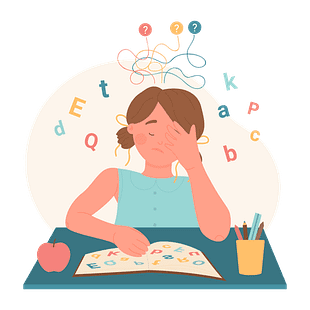Characteristics of Specific Learning Disabilities
Characteristics of Specific Learning Disabilities

Dyscalculia
- Difficulty understanding place value, quantity, number lines, positive and negative numbers, and carrying or borrowing.
- Struggles with understanding and solving word problems.
- Difficulty organizing information or events.
- Trouble following the steps involved in mathematical operations.
- Difficulty understanding fractions.
- Challenges in making change and managing money.
- Difficulty recognizing patterns in addition, subtraction, multiplication, or division.
- Struggles with mathematical processes involving language.
- Difficulty understanding concepts related to time (days, weeks, months, seasons, etc.).
Dysgraphia
- Difficulty writing legibly and spelling, even with time and attention.
- Shows inconsistencies in writing (e.g., inconsistent letter sizes, shapes, or slants).
- May leave out words or letters, or write incomplete words.
- Inconsistent spacing between words and letters.
- Grips the pen or pencil awkwardly while writing.
- Difficulty visualizing the formation of letters in the mind.
- Slow or laborious copying or writing.
- Difficulty writing in a straight line.
- Finds it challenging to think and write simultaneously (e.g., taking notes).


Dyslexia
- Reads slowly and with difficulty.
- Struggles with writing.
- Shows a significant gap between listening comprehension and reading comprehension.
- Difficulty with spelling.
- May have poor handwriting.
- Trouble remembering familiar words.
- Difficulty with written language.
- Struggles with mathematical calculations.
Nonverbal Learning Disabilities
- Difficulty recognizing non-verbal cues such as facial expressions or body language.
- Struggles with coordination between visual and auditory input and actions.
- Frequently bumps into or collides with other children.
- Difficulty with fine motor skills, like tying shoes or using scissors.
- Needs verbal descriptions to understand spatial orientation, directional concepts, and coordination.
- Difficulty coping with changes in routine.
- Struggles to generalize previously learned information.
- Difficulty following step-by-step instructions.
- Often takes instructions literally.
- Asks too many inappropriate questions that may disrupt the flow of a lesson.
- Appears knowledgeable due to strong verbal skills, but lacks understanding.
















































